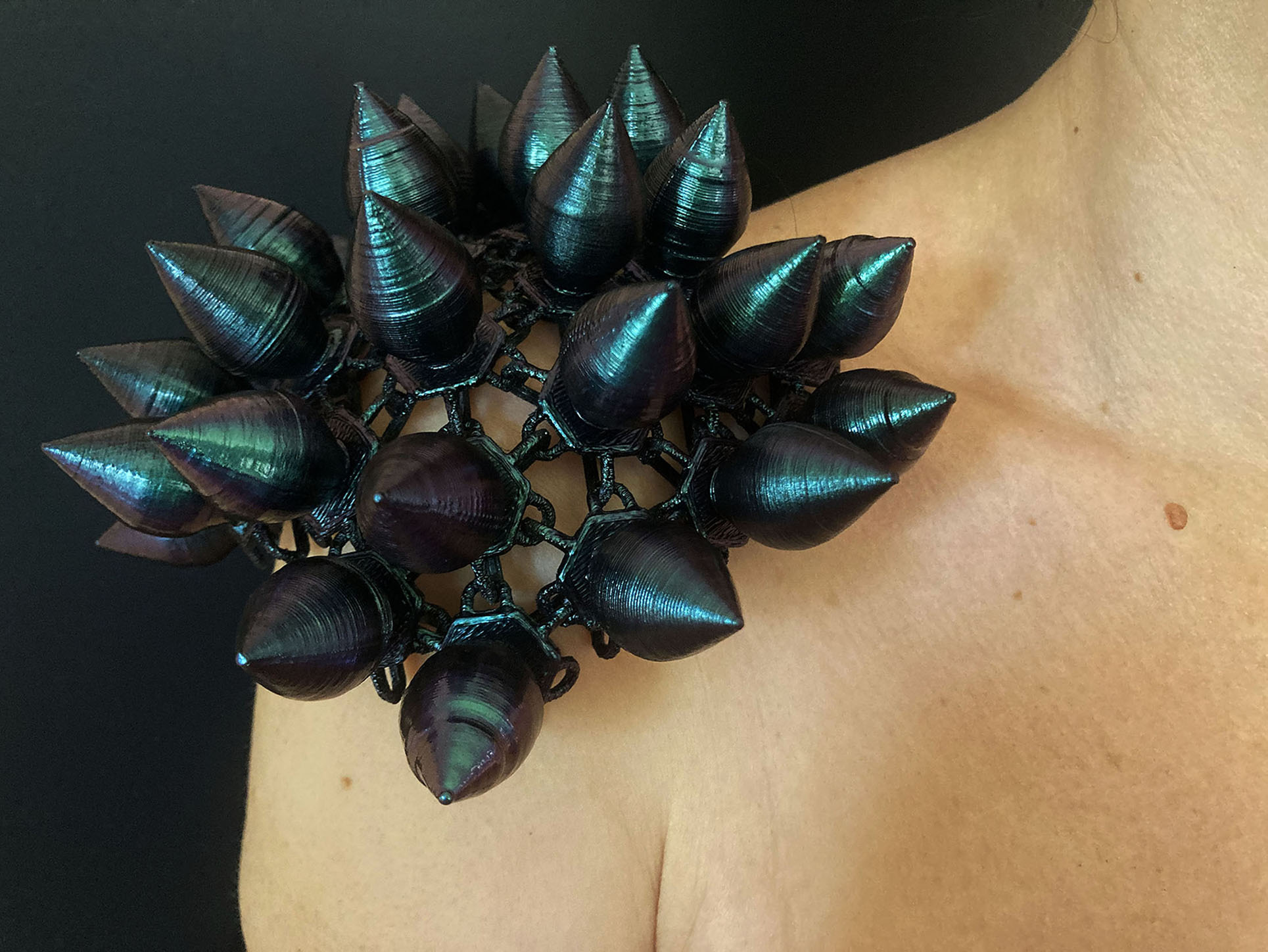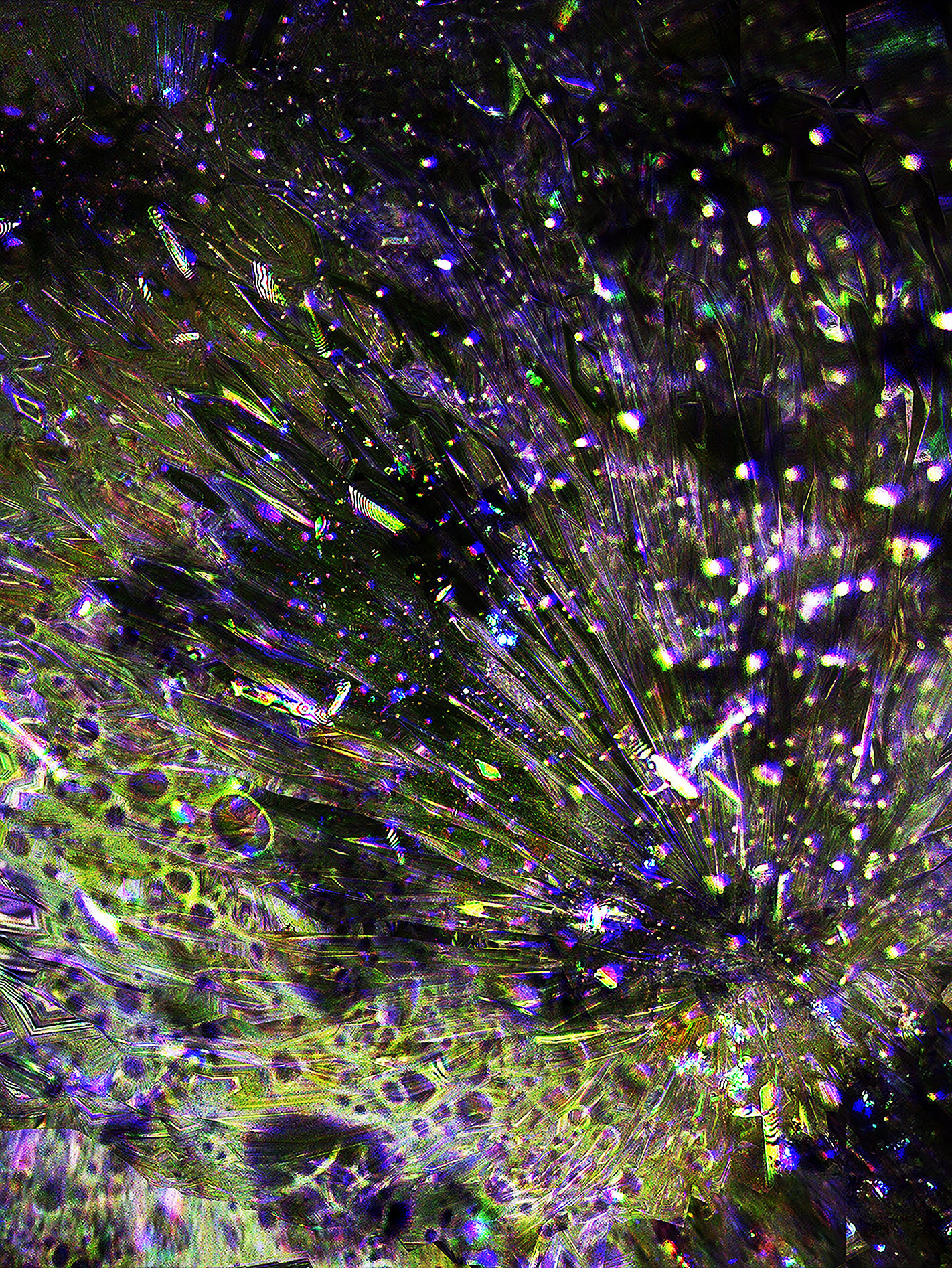Final year project
Interface [Read more]

Benzene
This piece is from my final major project, Interface, which responds directly to the NASA funded discovery of the eight-letter genetic code which suggests how alternate life might evolve. In this project, I have created a series of second-skins which act as a high-fashion, textile thought experiment. As clothes define the body, in this project I have attempted to show how the interface between potential intergalactic species and humans can allow for a definition of identity which extends beyond the bounds of an existentially threatened Earth.
Matter: This 3D-printed and laser-cut mesh explores the idea of alternate carbon-based life and its macro-kinetic structure mirrors the ring bonding of carbon atoms, as connected in the benzene molecule.
Method: Digital print, laser and 3D print.
Material: Acrylic Perspex and acrylic painted PLA filament.


Cosmic Particles
Matter: In simulated conditions, upon contact with the astrophysical plasma, cosmic dust particles have been seen arranging themselves into helical structures that bear resemblance to DNA and begin to exhibit life-like behaviour, reproducing into more stable forms and passing on information. In fact, some researchers believe this is all the needed criteria to be classed as inorganic life forms.
Method: Digital Print
Material: Double Georgette (100% silk)


Bioluminescence
Matter: This psychedelic digital print imagines the idea of bioluminescence radiating from the skin of alternate life. On Earth bioluminescence is a phenomenon where an organism produces and emits light, usually in the absence or restriction of sunlight, and most commonly in deep-sea environments.
Method: Digital print
Material: Spandex Satin (95% silk, 5% elastane)


Symbiosis
Matter: Envisioning the idea of autonomy and collective co-operation, the root of a lot of multi-cellular life forms, this piece portrays a dynamic relationship in structure, and leads to both this protective and threatening outer shell.
Method: 3D Print
Material: Acrylic painted PLA filament.


Neutron Sea
Matter: This digitally printed repeat tile encapsulates the complex particle sea of neutrons and subatomic particles beneath the crust of a neutron star. Theoretically, under this particular environment, the particles follow completely different laws of chemistry and might meet the basic conditions for life.
Method: Digital Print
Material: Layered Georgette (100% silk)


Crystalline
Matter: Responding directly to the scientific discovery that nature can be induced to incorporate silicon into carbon-based molecules. This digital print hypothesizes the crystallized skin of organosilicon-based life. This crystalline creature inhabits frozen, colder climates without the presence of oxygen, such as Saturn’s icy moon, Titan.
Method: Digital Print
Material: Double Georgette (100% silk)


Alta-Flori
Matter: The concept for this digital print was the possibility of alternate plant life. This alternate flora inhabits a high-gravity environment, floating high above the surface, and casts a vivid hue viewed from distant planets.
Method: Digital Print
Material: Material: Spandex Satin (95% silk, 5% elastane)
See the full range of my design work in my digital portfolio (Behance link)
Persia Eshtyaghi-Glass
A digital textile design student with an emphasis on utilising digital print and 3D print, laser cutting and jacquard weave to create innovative high-fashion outcomes.
Inspired by science and hypothetical biochemistry, my textile design approach and outcomes heavily reflect this. In my work I like to combine my extensive research into relevant scientific discoveries in the context of our own human mortality, which fuels me to create high-fashion textile outcomes in response to this idea of future wear.
I achieved these outcomes in my final major project, Interface, through my highly proficient digital skills in CAD software, such as Adobe Photoshop, Illustrator, ScotWeave (Jacquard). and communicating my ideas both clearly and creatively through InDesign. My main tool for designing using this software was my Wacom tablet which I used in combination with a digital collage of my original microscopy photography and skin cells. I also have shown particular interest in the construction of my own textile fabric, not only in a jacquard weave but also in the kinetic structures of my 3D-printed meshes which themselves have been inspired by molecular structures. I hope to combine this wide and diverse range of technical skills to create innovative and futuristic outcomes in the fashion and textiles industry where I feel they will be relevant.
Final year project
Interface